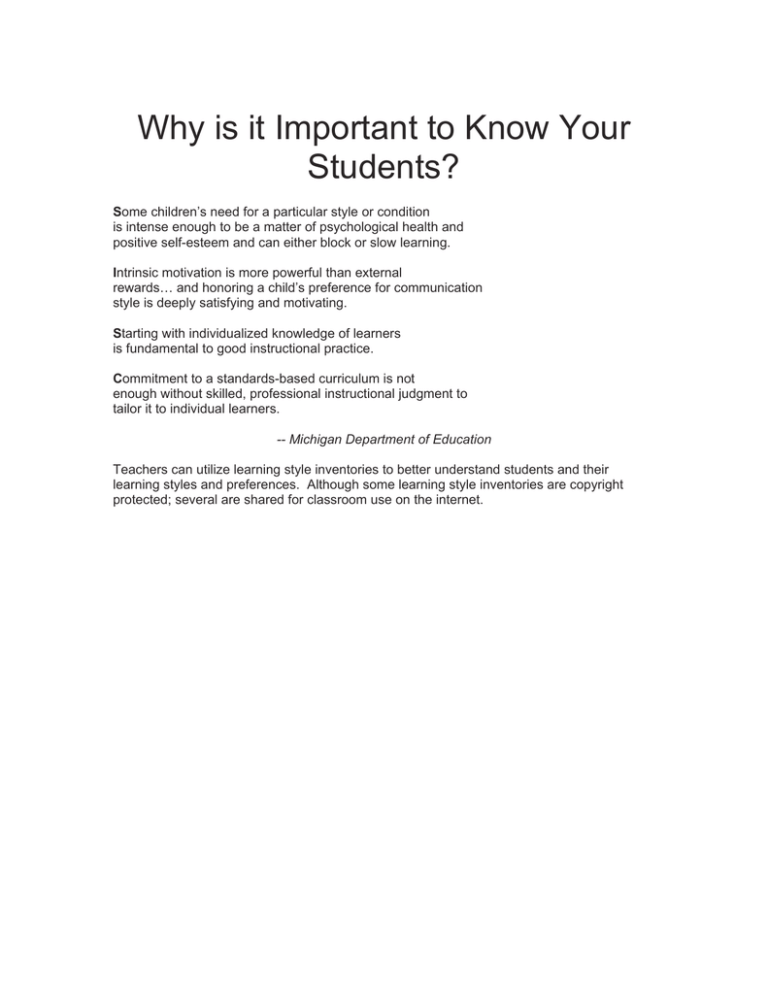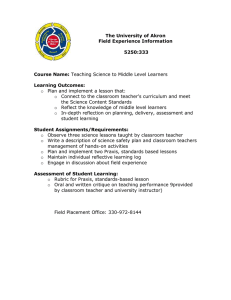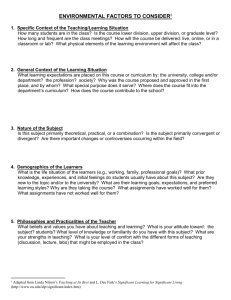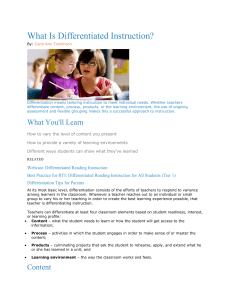Why is it Important to Know Your Students?
advertisement

Why is it Important to Know Your Students? Some children’s need for a particular style or condition is intense enough to be a matter of psychological health and positive self-esteem and can either block or slow learning. Intrinsic motivation is more powerful than external rewards… and honoring a child’s preference for communication style is deeply satisfying and motivating. Starting with individualized knowledge of learners is fundamental to good instructional practice. Commitment to a standards-based curriculum is not enough without skilled, professional instructional judgment to tailor it to individual learners. -- Michigan Department of Education Teachers can utilize learning style inventories to better understand students and their learning styles and preferences. Although some learning style inventories are copyright protected; several are shared for classroom use on the internet. Key Principles of aa Differentiated Classroom The The teacher teacher is clear clear about about what matters in subject matter. The teacher teacher understands, appreciates, and builds upon student differences. Assessment and instruction are inseparable. The teacher teacher adjusts content, process, and product product in response to student student readiness, interests, and learning profile. profile. All students students participate participate in in respectful work. Students and teachers teachers are are collaborators in learning. Goals of a differentiated differentiated classroom classroom are are maximum growth and individual success. Flexibility is the the hallmark hallmark of of aa differentiated differentiated classroom. Source: Tomlinson, C. (2000). Differentiating Instruction for Academic Diversity. San Antonio, TX: ASCD Best Practices for Standards-based Instruction Student Voice and Involvement Balanced with teacher-chosen and teacher-directed activities: Students often select inquiry topics, books, writing topics, etc. Students maintain their own records, set goals, and self-assess Some themes / inquiries are built from students’ own questions Students assume responsibility and take roles in decision making Best Practices for Standards-based Instruction Physical Facilities From: Set-up for teachercentered instruction (separate desks) Rows of desks Bare, unadorned space Textbooks and handouts To: Set-up for studentcentered instruction (tables, U-shaped) Clusters, centers, etc. Student work, friendly Purposeful materials Best Practices for Standards-based Instruction Classroom Climate / Management From: Punishment and rewards Teacher-created and enforced rules Passive learning Solely ability grouping Rigid schedule To: Engagement and community Students help set and enforce norms Purposeful engagement Flexible grouping Flexible time based on activity Best Practices for Standards-based Instruction Activities and Assignments From: Teacher presentation Whole-class instruction Uniform curriculum Short-term lessons Memorization and recall Short responses, fill-in- the-blank Same assignments To: Students experiencing concepts Centers, groups, variety Topics by students’ needs or choice Extended activities Application and problem solving Complex responses, evaluations and writing Multiple intelligences, cognitive styles Best Practices for Standards-based Instruction Language and Communication From: Forced constant silence Short responses Teacher talk Focus on facts To: Noise, conversation alternates with quiet Elaborated discussions Student-teacher, student-student Skills, concepts, synthesis, evaluation Learning Environment Examples of differentiating learning environment at the elementary level include: Making sure there are places in the room to work quietly and without distraction, as well as places that invite student collaboration; Providing materials that reflect a variety of cultures and home settings; Setting out clear guidelines for independent work that matches individual needs; Developing routines that allow students to get help when teachers are busy with other students and cannot help them immediately; and Helping students understand that some learners need to move around to learn, while others do better sitting quietly (Tomlinson, 1995, 1999; Winebrenner, 1992, 1996). Content Examples of differentiating content at the elementary level include the following: Using reading materials at varying readability levels; Putting text materials on tape; Using spelling or vocabulary lists at readiness levels of students; Presenting ideas through both auditory and visual means; Using reading buddies; and Meeting with small groups to re-teach an idea or skill for struggling learners, or to extend the thinking or skills of advanced learners. Process Examples of differentiating process or activities at the elementary level include the following: Using tiered activities through which all learners work with the same important understandings and skills, but proceed with different levels of support, challenge, or complexity; Providing interest centers that encourage students to explore subsets of the class topic of particular interest to them; Process (continued) Developing personal agendas (task lists written by the teacher and containing both in-common work for the whole class and work that addresses individual needs of learners) to be completed either during specified agenda time or as students complete other work early; Offering manipulatives or other hands-on supports for students who need them; and Varying the length of time a student may take to complete a task in order to provide additional support for a struggling learner or to encourage an advanced learner to pursue a topic in greater depth. Products Examples of differentiating products at the elementary level include the following: Giving students options of how to express required learning (e.g., create a puppet show, write a letter, or develop a mural with labels); Using rubrics that match and extend students' varied skills levels; Allowing students to work alone or in small groups on their products; and Encouraging students to create their own product assignments as long as the assignments contain required elements. THINKING ABOUT ON-GOING ASSESSMENT STUDENT DATA SOURCES 1. Journal entry 2. Short answer test 3. Open response test 4. Home learning 5. Notebook 6. Oral response 7. Portfolio entry 8. Exhibition 9. Culminating product 10. Question writing 11. Problem solving TEACHER DATA MECHANISMS 1. Anecdotal records 2. Observation by checklist 3. Skills checklist 4. Class discussion 5. Small group interaction 6. Teacher – student conference 7. Assessment stations 8. Exit cards 9. Problem posing 10. Performance tasks and rubrics




